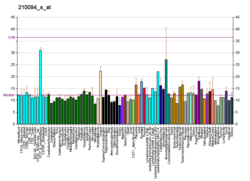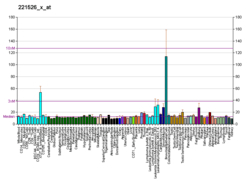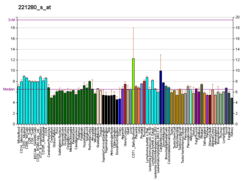PARD3
Partitioning defective 3 homolog is a protein that in humans is encoded by the PARD3 gene.[5][6]
Function
PARD proteins, which were first identified in C. elegans, are essential for asymmetric cell division and polarized growth, whereas CDC42 (MIM 116952) mediates the establishment of cell polarity. The CDC42 GTPase, which is controlled by nucleotide exchange factors (GEFs; see MIM 606057) and GTPase-activating proteins (GAPs; see MIM 604980), interacts with a large set of effector proteins that typically contain a CDC42/RAC (MIM 602048)-interactive binding (CRIB) domain.[supplied by OMIM][6]
Interactions
PARD3 has been shown to interact with:
References
- 1 2 3 GRCh38: Ensembl release 89: ENSG00000148498 - Ensembl, May 2017
- 1 2 3 GRCm38: Ensembl release 89: ENSMUSG00000025812 - Ensembl, May 2017
- ↑ "Human PubMed Reference:".
- ↑ "Mouse PubMed Reference:".
- ↑ Joberty G, Petersen C, Gao L, Macara IG (Oct 2000). "The cell-polarity protein Par6 links Par3 and atypical protein kinase C to Cdc42". Nat Cell Biol. 2 (8): 531–9. doi:10.1038/35019573. PMID 10934474.
- 1 2 "Entrez Gene: PARD3 par-3 partitioning defective 3 homolog (C. elegans)".
- 1 2 Ebnet K, Aurrand-Lions M, Kuhn A, Kiefer F, Butz S, Zander K, Meyer zu Brickwedde MK, Suzuki A, Imhof BA, Vestweber D (Oct 2003). "The junctional adhesion molecule (JAM) family members JAM-2 and JAM-3 associate with the cell polarity protein PAR-3: a possible role for JAMs in endothelial cell polarity". J. Cell Sci. 116 (Pt 19): 3879–91. doi:10.1242/jcs.00704. PMID 12953056.
- ↑ Kohjima M, Noda Y, Takeya R, Saito N, Takeuchi K, Sumimoto H (Dec 2002). "PAR3beta, a novel homologue of the cell polarity protein PAR3, localizes to tight junctions". Biochem. Biophys. Res. Commun. 299 (4): 641–6. doi:10.1016/s0006-291x(02)02698-0. PMID 12459187.
- ↑ Takekuni K, Ikeda W, Fujito T, Morimoto K, Takeuchi M, Monden M, Takai Y (Feb 2003). "Direct binding of cell polarity protein PAR-3 to cell-cell adhesion molecule nectin at neuroepithelial cells of developing mouse". J. Biol. Chem. 278 (8): 5497–500. doi:10.1074/jbc.C200707200. PMID 12515806.
Further reading
- Johansson A, Driessens M, Aspenström P (2000). "The mammalian homologue of the Caenorhabditis elegans polarity protein PAR-6 is a binding partner for the Rho GTPases Cdc42 and Rac1". J. Cell Sci. 113 (18): 3267–75. PMID 10954424.
- Eichmuller S, Usener D, Dummer R, Stein A, Thiel D, Schadendorf D (2001). "Serological detection of cutaneous T-cell lymphoma-associated antigens". Proc. Natl. Acad. Sci. U.S.A. 98 (2): 629–34. doi:10.1073/pnas.021386498. PMC 14639. PMID 11149944.
- Suzuki A, Yamanaka T, Hirose T, Manabe N, Mizuno K, Shimizu M, Akimoto K, Izumi Y, Ohnishi T, Ohno S (2001). "Atypical protein kinase C is involved in the evolutionarily conserved par protein complex and plays a critical role in establishing epithelia-specific junctional structures". J. Cell Biol. 152 (6): 1183–96. doi:10.1083/jcb.152.6.1183. PMC 2199212. PMID 11257119.
- Noda Y, Takeya R, Ohno S, Naito S, Ito T, Sumimoto H (2001). "Human homologues of the Caenorhabditis elegans cell polarity protein PAR6 as an adaptor that links the small GTPases Rac and Cdc42 to atypical protein kinase C.". Genes Cells. 6 (2): 107–19. doi:10.1046/j.1365-2443.2001.00404.x. PMID 11260256.
- Ebnet K, Suzuki A, Horikoshi Y, Hirose T, Meyer Zu Brickwedde MK, Ohno S, Vestweber D (2001). "The cell polarity protein ASIP/PAR-3 directly associates with junctional adhesion molecule (JAM)". EMBO J. 20 (14): 3738–48. doi:10.1093/emboj/20.14.3738. PMC 125258. PMID 11447115.
- Fang CM, Xu YH (2002). "Down-regulated expression of atypical PKC-binding domain deleted asip isoforms in human hepatocellular carcinomas". Cell Res. 11 (3): 223–9. doi:10.1038/sj.cr.7290090. PMID 11642408.
- Gao L, Macara IG, Joberty G (2003). "Multiple splice variants of Par3 and of a novel related gene, Par3L, produce proteins with different binding properties". Gene. 294 (1–2): 99–107. doi:10.1016/S0378-1119(02)00681-9. PMID 12234671.
- Kohjima M, Noda Y, Takeya R, Saito N, Takeuchi K, Sumimoto H (2003). "PAR3beta, a novel homologue of the cell polarity protein PAR3, localizes to tight junctions". Biochem. Biophys. Res. Commun. 299 (4): 641–6. doi:10.1016/S0006-291X(02)02698-0. PMID 12459187.
- Takekuni K, Ikeda W, Fujito T, Morimoto K, Takeuchi M, Monden M, Takai Y (2003). "Direct binding of cell polarity protein PAR-3 to cell-cell adhesion molecule nectin at neuroepithelial cells of developing mouse". J. Biol. Chem. 278 (8): 5497–500. doi:10.1074/jbc.C200707200. PMID 12515806.
- Warner DR, Pisano MM, Roberts EA, Greene RM (2003). "Identification of three novel Smad binding proteins involved in cell polarity". FEBS Lett. 539 (1–3): 167–73. doi:10.1016/S0014-5793(03)00155-8. PMID 12650946.
- Brajenovic M, Joberty G, Küster B, Bouwmeester T, Drewes G (2004). "Comprehensive proteomic analysis of human Par protein complexes reveals an interconnected protein network". J. Biol. Chem. 279 (13): 12804–11. doi:10.1074/jbc.M312171200. PMID 14676191.
- Navarro-Lérida I, Martínez Moreno M, Roncal F, Gavilanes F, Albar JP, Rodríguez-Crespo I (2004). "Proteomic identification of brain proteins that interact with dynein light chain LC8". Proteomics. 4 (2): 339–46. doi:10.1002/pmic.200300528. PMID 14760703.
- Brill LM, Salomon AR, Ficarro SB, Mukherji M, Stettler-Gill M, Peters EC (2004). "Robust phosphoproteomic profiling of tyrosine phosphorylation sites from human T cells using immobilized metal affinity chromatography and tandem mass spectrometry". Anal. Chem. 76 (10): 2763–72. doi:10.1021/ac035352d. PMID 15144186.
- Liu XF, Ishida H, Raziuddin R, Miki T (2004). "Nucleotide exchange factor ECT2 interacts with the polarity protein complex Par6/Par3/protein kinase Czeta (PKCzeta) and regulates PKCzeta activity". Mol. Cell. Biol. 24 (15): 6665–75. doi:10.1128/MCB.24.15.6665-6675.2004. PMC 444862. PMID 15254234.
- Beausoleil SA, Jedrychowski M, Schwartz D, Elias JE, Villén J, Li J, Cohn MA, Cantley LC, Gygi SP (2004). "Large-scale characterization of HeLa cell nuclear phosphoproteins". Proc. Natl. Acad. Sci. U.S.A. 101 (33): 12130–5. doi:10.1073/pnas.0404720101. PMC 514446. PMID 15302935.
- Jin J, Smith FD, Stark C, Wells CD, Fawcett JP, Kulkarni S, Metalnikov P, O'Donnell P, Taylor P, Taylor L, Zougman A, Woodgett JR, Langeberg LK, Scott JD, Pawson T (2004). "Proteomic, functional, and domain-based analysis of in vivo 14-3-3 binding proteins involved in cytoskeletal regulation and cellular organization". Curr. Biol. 14 (16): 1436–50. doi:10.1016/j.cub.2004.07.051. PMID 15324660.
This article is issued from
Wikipedia.
The text is licensed under Creative Commons - Attribution - Sharealike.
Additional terms may apply for the media files.







